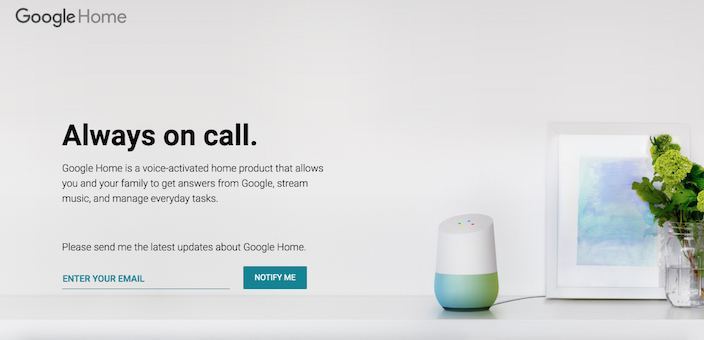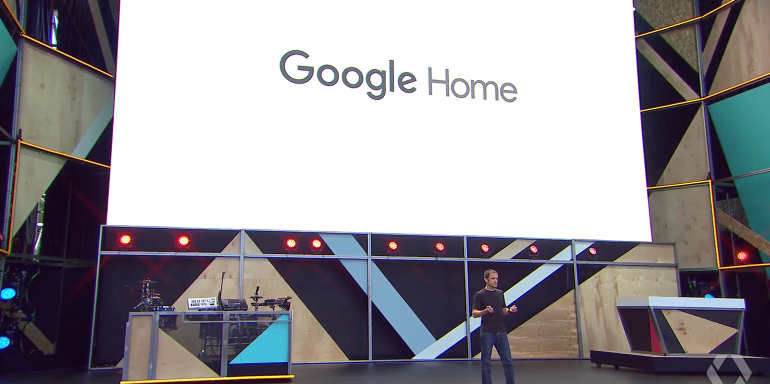We’re becoming more “connected” with each passing day — and that increased connectivity exists mainly “in” our phones. First it was our email, then our social networks, our cars — and now our homes — are the next big thing to sync with our smartphones.
Many companies are capitalizing on this trend. You already see lighting, thermostats, door locks, security cameras — you name it, becoming “smart.” What’s smarter than these tools are the companies getting into the home automation system market. It is estimated that by the year 2022 the market will be worth roughly $78.27 billion.
If you happened to be near Google’s headquarters last Tuesday, you would have thought Super Bowl 50 came back to town due to the amount of traffic in the area. There wasn’t a game in sight, just Google I/O 2016.
Google announced ten new products — everything from a new VR platform, to a new messaging app, to Android’s newest OS (still in beta for now), and a smart speaker.
That smart speaker is Google Home.
What is Google Home?
Google Home is the search juggernaut’s version of a smart home automation system that combines search engine capabilities and artificial intelligence into everything we do.
Much like the Amazon Echo, Google Home is triggered by voice activated commands that allow you to (among other things):
- Stream music
- Set calendar reminders
- Make to-do lists
- Check flight status
- Track packages
Some industry analysts assert that the Google speaker is a direct response (and potential threat) to Amazon’s Echo, a device that continues to enjoy great success in the emerging home automation market.
How is Google Home being promoted?
From a marketing perspective, we couldn’t help but notice how Google is promoting their new home automation software. If you search for Google’s new speaker online, their ad and organic search result both go to a post-click landing page. A coming soon post-click landing page to be exact.
If you don’t recall why a brand would use this type of page, let’s do a brief recap. Coming soon post-click landing pages help you:
- Announce a new product
- Create demand
- Capture emails to grow your list
This isn’t the first time we’ve seen Google use a post-click landing page to generate conversions, since they already published a click-through post-click landing page for their cloud platform. So it just goes to show Google believes in the power of post-click landing pages.
Below is the post-click landing page created for Google Home. It rotates between three separate backgrounds to give people an idea what it can look like with the decor in homes:



What the post-click landing page does well:
- The headline demonstrates that Google Home is always listening and ready to provide assistance with any voice-activated command.
- The form is very short, only requesting the person’s email.
- The CTA copy uses personalized copy (“me”) that speaks to the visitor.
- All three background images help the viewer envision Google Home in their home in three common places: the office, the kitchen, and the bedroom.
- The Privacy Policy in the footer provide visitors reassurance their personal information will be held safely.
What the post-click landing page could A/B test:
- The CTA color doesn’t really “pop” off the page as much as it could if it was designed using a contrasting color.
- Including a short video could really help the viewer understand Google Home’s UVP.
- The footer contains links to Google.com and “About Google,” which serve as distractions to the post-click landing page’s main goal: creating demand and growing Google’s email list.
Why choose a post-click landing page to promote ‘Home’?
Google isn’t naive. They may own the majority of search market share, but they’re pretty good marketers, too. They recognize that post-click landing pages have seen exponential demand over the past decade:
Also, Google understands that post-click landing pages should:
- Be highly relevant to their respective ad
- Be designed with a single goal in mind
- Include the necessary elements that persuade people to convert
We’ll probably never be privy to learn how many conversions their post-click landing page generates, but we’re willing to bet it’s more than if they didn’t use a post-click landing page.
Google Home vs. Amazon Echo: Is there a difference?
Unlike Echo, Google Home is designed to be used with multiple devices in multiple rooms, so you can ask a single query and not have to worry about three different devices answering back. And even though the Amazon Echo may be the market leader because it’s been around for a year and half and integrates with numerous other services already, Google Home will likely fit in better with your home decor. Plus it offers native notifications.
The real differentiator, however, is that Google search is built in.
For a quick summation of Google Home and how intuitive it can be with a myriad of daily tasks, watch this video:
It’s still a bit premature to state categorically whether or not Google Home will make a significant dent in Echo’s market share. A lot of that hinges on Home’s price point (TBD) and how many external services it will eventually pair with.
One thing is for sure: the Google Home post-click landing pages made a big splash. The pages effectively got the media’s attention, along with Google’s target audience, and, perhaps most impressive of all, their competitors.
Take it from Google (and other industry leaders)
Google Home will not be available until the Fall, but that didn’t stop Google from creating a post-click landing page to create demand and grow its email list.
We’ve talked about how Uber, Shopify, and Airbnb use post-click landing pages to generate signups. But if one of the most recognizable brands in the world trusts a post-click landing page to create demand and collect email addresses, shouldn’t you as well?
You can start building your post-click landing page, sign up for an Instapage Enterprise demo today.

See the Instapage Enterprise Plan in Action.
Demo includes AdMap™, Personalization, AMP,
Global Blocks, heatmaps & more.
